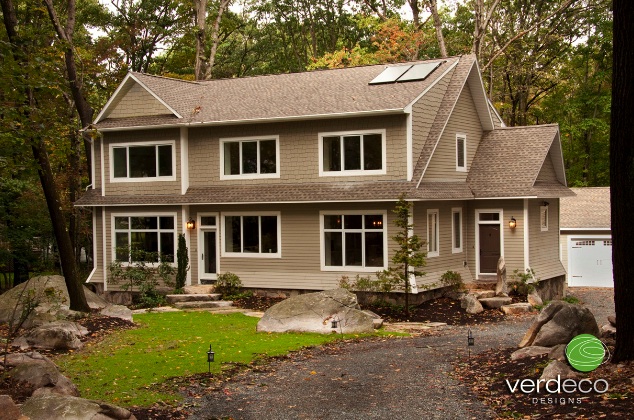
Image Credit: Verdeco Designs, Beaton Construction, and DEAP Energy Group
Image Credit: Verdeco Designs, Beaton Construction, and DEAP Energy Group The house includes a solar hot water system with an 80-gal. storage tank. The building’s airtightness – at 0.49 air changes per hour at 50 Pascals pressure difference – was well within the Passivhaus requirement. Though it wasn’t specified in the design, an unusual amount of cellulose insulation went into the attic, bringing the main ceiling to R-126.2. Exterior walls were insulated to R-65.7 on the first floor, R-58.2 on the second. Basement foundation walls were insulated to R-51.8, the slab floor to R-41.3.
As Paul Panish explained in a GBA post about builder Matthew Beaton’s home in Shrewsbury, Massachusetts, Beaton wasn’t aware of the Passivhaus standard when he first conceived of the project. By the time construction had started, though, he had became fully committed to the concept, even though there wasn’t time for a full-fledged redesign and Passivhaus modeling.
Decisions on major components such as window sizing and location, glazing characteristics, and basement thermal boundary “were being made after sections had been designed, as other building components were under construction, and the project was in a general state of flux,” writes Panish, a principal at DEAP Energy Group of Newton, Massachusetts, and Passivhaus consultant on the project. As a consequence, when a decision had to be made about construction details affecting the building’s eventual performance, Beaton and his team – which also included Mark Yanowitz of Verdeco Designs in Andover, and Richard Brown of Certified Energy Ratings in Hamilton – went with a “conservative approach.”
Nailing the results
The results include a slab floor insulated to R-41.3, basement foundation walls insulated to R-51.8, first-floor exterior walls to R-65.7, second-floor walls to R-58.2, and the main ceiling to R-126.2. Most of the above-grade insulation was cellulose (Beaton had plenty of it on hand, so he decided to use it where he could: there are 3 ft. of it in the attic).
The home’s air leakage rate is 0.44 air changes per hour at 50 Pascals. Mechanical equipment includes an UltimateAir RecoupAerator 200DX energy-recovery ventilator, a Mitsubishi MXZ-3A30NA minisplit air-source heat pump heating system, and a solar hot water system.
Beaton and his family have been living in the house since September. It was certified by Passive House Institute U.S. on July 13, becoming the first single-family Passivhaus dwelling in the state, Beaton says.
The project has been an exercise in perseverance. Panish points out that challenges involved in using a partially improvised approach to achieving the desired performance level provided “a valuable lesson in the justification for carrying out the analysis and pre-certification components of the PH design process.”
Aside from shifting the performance target to Passivhaus, however, Beaton had from the beginning approached the project with a number of conservation goals, including use of reclaimed foam board, lumber cut from the site, and stones excavated from the site for use on the patio and as wall veneer.
Weekly Newsletter
Get building science and energy efficiency advice, plus special offers, in your inbox.














0 Comments
Log in or create an account to post a comment.
Sign up Log in